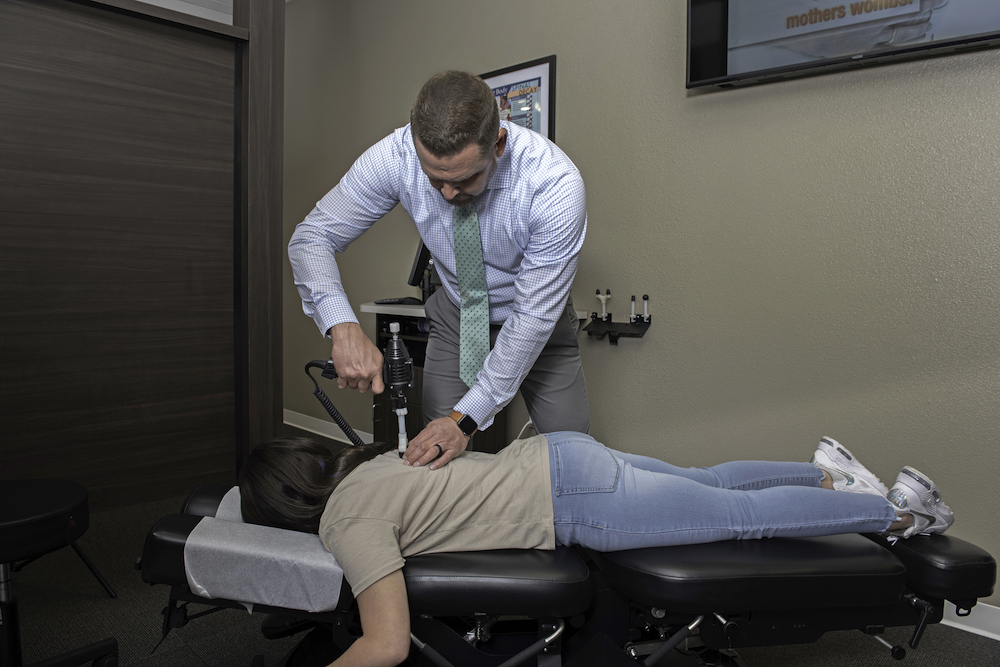What You Should Know About Lumbar Herniated Discs
4 min read

Herniated discs can occur in the lower part of your spine, also called the lumbar area of the spine. They cause a lot of pain, as you may already know! But you don’t have to suffer through it while it heals. There are a range of different chiropractic treatments we offer at Village Chiropractic in The Woodlands that can reduce the pain and help the disc heal faster.
What is a Lumbar Herniated Disc?
The term herniated disc refers to a condition in which one of your intervertebral discs, those cushions that lie between each vertebra, breaks or cracks in the lower back. The gel-like liquid that cushions the discs leaks out and the disc itself can push outward into your spinal canal. This puts pressure on your spinal nerves and causes pain in your back.
If you’ve ever overdone it out in the yard or worked out too hard causing a sore back, you know it’s a different kind of pain from a pulled muscle.
Causes of a Lumbar Herniated Disc
The most common cause of a lumbar herniated disc is physical trauma. Injury-related causes include any physical impact to your back, from car accidents and falls to sports-related trauma. It’s important to remember that minor injuries can often lead to more serious problems.
When we’re younger, the discs between our vertebrae have a higher water content. This keeps them more flexible and resistant to injury or damage. However, over time, this water content slowly decreases and leaves the discs more prone to cracking or tearing from even small movements or stresses. That is why, as you age, it’s important to recognize your risk factors to understand how to avoid injury.
Symptoms of a Lumbar Herniated Disc
When a lumbar disc becomes herniated, it can lead to pain and discomfort that travels down both legs. The effects of a lumbar herniated disc are typically felt below your waist. You may feel symptoms in your buttocks, thighs, and calves, or any area in your mid to lower back region.
A herniated disc in your lower back can cause a range of symptoms. For example, you may feel pain when standing up after sitting for an extended period of time. Or, if a lumbar herniated disc is located in an area close to your sciatic nerve, you may experience shooting pain that travels through your leg. A herniated disc can also lead to numbness or weakness.
As is true with other back injuries, not all herniated discs are painful. In fact, some people don’t feel any symptoms at all. But, even when a lumbar herniated disc doesn’t produce symptoms, it can still lead to complications. An undiagnosed or untreated lumbar herniated disc could result in sciatica — or more serious side effects such as neurological symptoms and leg weakness or inability to pick up your feet.
Risk Factors and Preventing Herniated Discs
The risk factors for a lumbar herniated disc can be divided into two groups: things you can control and factors you can’t change. It’s important to understand the different risk factors so you can identify the potential for issues. Some of the factors that we can’t include are family histories, natural aging, and your gender.
Fortunately, there are a number of factors that you can control to help reduce the risk of a herniated disk. These include eating a healthy diet, maintaining a healthy body weight, using proper lifting form when at home or work, getting regular exercise, and quitting smoking.
While exercise is an important activity to help reduce your risk of a herniated disk, high-impact activities may contribute or cause the issue to occur. Try to avoid high-impact exercises. There are plenty of low-impact activities that will help keep your body fit without raising your risk for serious injuries. These activities include swimming, walking, yoga, or water aerobics among many others. If you are concerned about your exercise routine, speak with a chiropractor about activities that would suit your needs.
How Can a Chiropractor Help a Herniated Disc in the Lower Back?
Regardless of how you get a herniated lumbar disk, it may result in your spine being cracked or misaligned. A chiropractor is trained not only to diagnose and treat your condition but also to find out why it happened.
Your chiropractor will diagnose the exact cause of your pain, and may even decide to use an x-ray machine or an MRI scan during this process. After finding out why your disc has been damaged, you’ll be able to take steps to avoid further injury. Your chiropractor will also be able to offer a course of treatment for your herniated disc, which can help speed up recovery time.
You’ll receive an exam of the entire spine to determine which treatment options are the best fit for your condition. Quite often with chiropractic care patients can feel relief quickly from a herniated disc.
There are a variety of different techniques that chiropractors use to treat herniated discs. One of the most common treatments is the use of decompression. This approach allows the spine to naturally stretch which can help to reduce specific points that may be causing pain in the herniated disc. At Village Chiropractic in The Woodlands, we use cutting edge Back on Trac spinal traction technology for many types of lower back pain.
Cold laser therapy is another method used by chiropractors to bring blood flow to the affected area so that it can stimulate healing. You’ll just need to lie under the cold laser light for 10-15 minutes per sessions for the healing effects to work.
For most patients with a herniated disc, several treatment sessions are needed to feel lasting relief. Even if you start to feel better stay with your treatment plan for the full effect.
Contact Village Chiropractic in The Woodlands
Your health is important, and painful back issues can affect your day-to-day routines. If you’ve been experiencing lower back pain, or you’ve been told you have a herniated disc, consider visiting a chiropractor for treatment without the use of prescription pain medications.
Request an appointment at our location in Alden Bridge for an assessment and treatment plan for your lower back pain.





